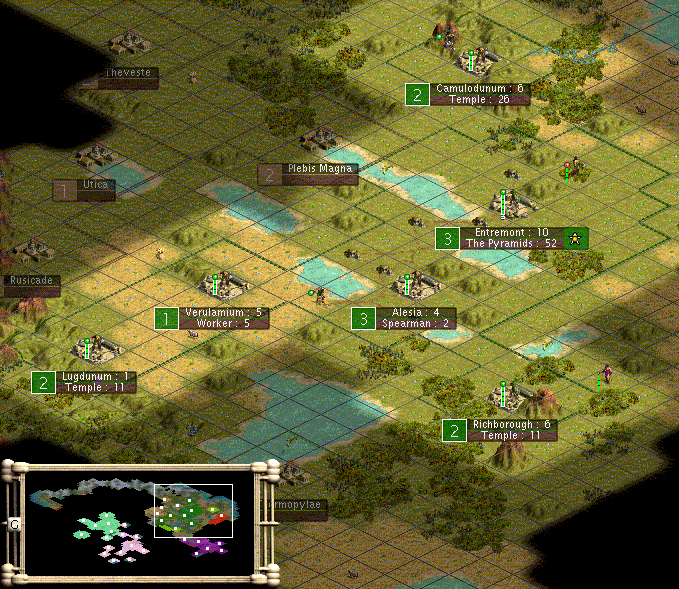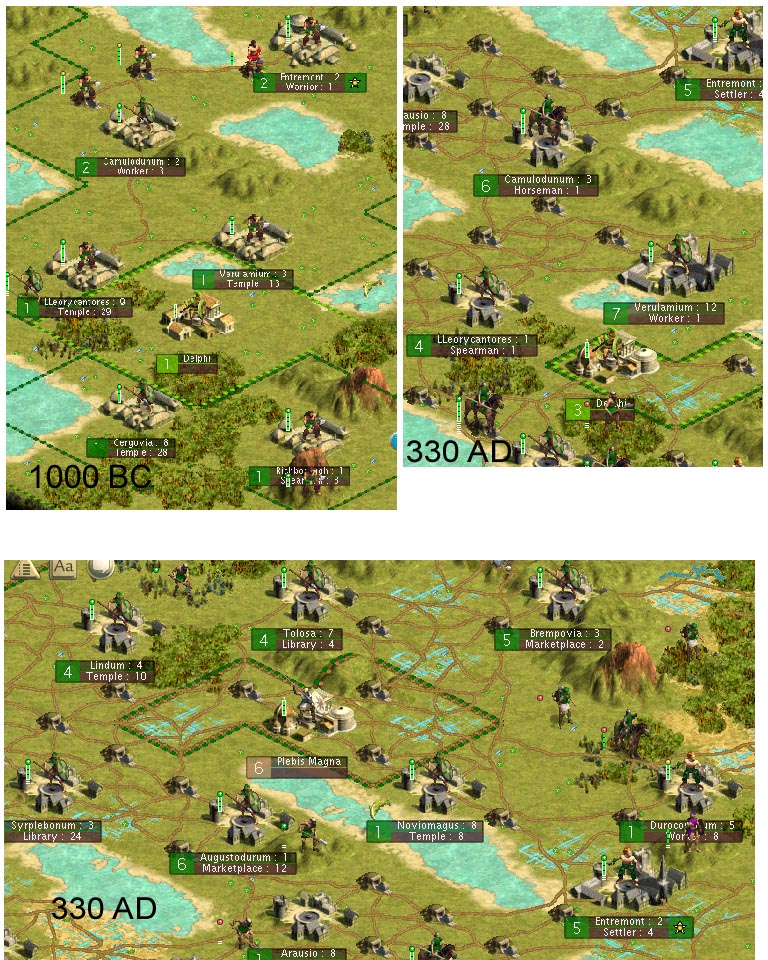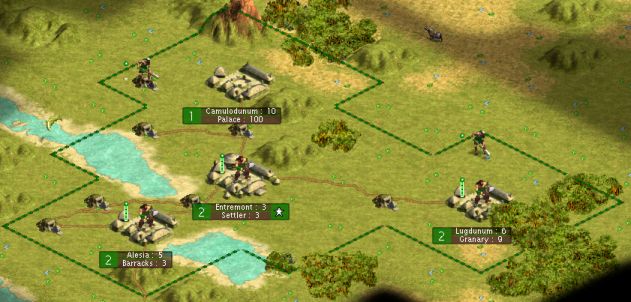Wow. I told myself that I wouldn't let myself look in this thread until I finished editing my pictures for the QSC, and it's a good thing I did as I just submitted it under the wire. I qualified to look in this thread yesterday, and I'm glad I waited to do so until now as there's a lot to catch up on. RL forced short sessions rather than long-term study, and I'm not sure how this QSC will turn out as a result.
My QSC focused on building a strong core of cities to either go for a space race, diplo win, or knight-domination later on; I just discovered Feudalism, and I'm not sure which I will do at this point. I've grabbed one 40-turn gambit by the QSC period, which helped my income and my infrastructure as the cash allowed me to buy guest workers to work my lands. A quick summary of my QSC:
4000 BC: Worker goes NW and spots fish; settler follows as that¡¦s bonus food.
3950 BC: Entremont founded; research to 100% on Pottery; warrior production started. Worker goes south to mine there.
(Entremont Warrior-Warrior-Worker-Warrior.)
3200 BC: I get a free settler! There's a screenshot in the QSC, but the hut I popped it from was the Marcomanni, south of Entremont near the mountains.
3150 BC: Entremont builds warrior; starts temple prebuild for granary. Sliders adjusted for unit upkeep. Warrior exploring to northwest sees brown borders that probably indicate a Carthagnian presence.
3050 BC: Contact with Carthage. Hannibal gives us Masonry + 10 gold for Warrior Code and Ceremonial Burial; not bad for the two cheapest techs.
3000 BC: Pottery discovered; research turned off for a turn or two as I see purple borders and I don't want to waste gpt on something I might immediately trade for. Entremont swapped to Granary.
2950 BC: Contact with Hiawatha! We trade him Masonry for Mysticism + 2 gold. 40-turn research started on Polytheism.
2900 BC: Alesia founded; starts warrior.
2750 BC: Both warriors see pale green boundaries, probably the Greeks.
2710 BC: Contact with Alex. We do a 3-for-2 tech deal, giving him Masonry, CB, Pottery, and 4 gold for Alphabet and BW. Not bad for catching him up to the other 2 AI I know in tech. He lacks Mysticism, but it's not worth selling for 25 gold yet as Hannibal also doesn't know it.
In the next turn, my warrior sees a Pict wandering about, which is captured in the QSC.
2590 BC: Entremont MMed to work the forest tile for 1 turn so that the granary is built before it grows.
2550 BC: Entremont builds granary; forest tile swapped to work fish.
2470 BC: A pale blue scout runs by too fast for our warrior to hail it. Entremont builds warrior; starts settler. Alesia builds worker; starts temple so it will be able to work the freshwater fish nearby.
2430 BC: That wasn't a scout- that was a Jag! Contact with Monty reveals that he is way behind in tech.
2350 BC: Entremont MMed to build the settler when it grows, and use the lake tiles in the meantime.
2190 BC: Evidently Alex popped a free settler near the Iroquois as he has a city far to the south. Entremont builds settler; starts spear.
2070 BC: Contact with Mao via a wandering Chinese archer near the Iroquois homelands allows me to trade him Mysticism for Iron Working + 10 gold. I also buy two 'guest workers' from Alex for 122g + 5 gpt, expensive but worth it- I'll be able to swap Polytheism around for tech and cash to get it back later.
Alesia finishes its temple shortly thereafter, and it joins Entremont in a nearly continuous run of spear-settler alternating production.
1910 BC: Lugundum founded
1830 BC: Camulodunum founded
1790 BC: Alesia expands to grab the fish; the Aztecs start the Oracle. Mao has The Wheel and 10 gold, which I trade him Alphabet for- he must not know both Greece and Carthage yet.
1700 BC (IT): France and Egypt contact me out of the blue, wanting to sell me contacts with Japan. The Iroquois start the Oracle. I guess the AI managed to get Writing and swap contacts in the interturn.
1575 BC: Richborough founded.
1550 BC (IT): The Iroquois demand gold and I call their bluff. It is a bluff, and Hiawatha calls me 'courageous.' Ha. Alex tries to sell me Contact with Japan again, but I'm not taking it until I get Polytheism and can trade it.
1500 BC: Verulamium founded. Most of the AIs have started the Oracle by now.
1475 BC: Polytheism discovered; 40-turn research started on Monarchy. Hiawatha is the only civ with Math, which he gives me along with HBR and all his gold for Polytheism. Alex gives me contact with Japan, Writing, and 15 gold for Polytheism. More selling of Math all around (as some of the AI appear to be having it soon given that they wouldn't give Writing for it in the first place) nets me 193 gold, with the only lacking toy being contact with Rome. Hiawatha will probably sell that to someone else first, or my warrior will find Caesar- as Rome doesn't know anyone but the Iroquois, it's probably not worth buying contact with as there will be nothing to trade there.
1400 BC: A Roman warrior wanders by Entremont. Contact with Rome, plus 33 gold, is enough to get a worker from Carthage. Also, Hiawatha has money again, meaning that I sell him contact with Japan for 22 gold. Embassies in Greece, Rome, Carthage, and the Iroquois prove to be cost-effective at this point, giving me links to all my close neighbors. A warrior near Egypt pops a hut, disturbing Pictish warriors.
1375 BC (IT): Rome declares war on the Iroquois. Great- that will allow me to backfill and divert Hiawatha, who is looking enviously at my lands.
1275 BC: Gergovia is founded, barely beating Greece to the nearby dyes. It immediately starts a temple.
1100 BC: Lleryocantores and Brempovia founded.
1050 BC: Syrplebonum founded.
1025 BC: Contact with England! Liz knows Map Making, but is incredibly far behind the other AI in most respects- she must have been forced to beeline for it, and is probably on an island. Masonry, CB, IW, HBR get Map Making, her WM, and 60 gold. She has cultural boundaries near the Iroquois, but doesn't know them yet. I trade outdated techs to Mao and Caesar for their World Maps, revealing a great deal of the continent. I don't want to sell mine yet, as that provokes AI settling, but I could if I wanted to for a great deal of gold. Liz is cooped up in an ugly jungle belt of an island, and will probably meet Hiawatha as soon as she builds a galley. For now, I am content to wait and see if the other AI get tech I can trade contact with her for first.
1000 BC: Entremont builds settler; starts spear. Verulamium builds worker; starts temple. China and Greece have Code of Laws, and I buy it from China for 217 gold, then sell it all around for maps and gold, making most of it back in money and map knowledge, most importantly that there appears to be a peninsula off the north coast- given what cracker did in Rome¡¦s GOTM, I suspect that I had better heavily escort any settlers that venture near there.
The Celtic Despotism in 1000 BC:
To give an idea of my relative strength at this point, I had three guest workers, six native workers, two settler/spear pairs out, five warriors, nine spearmen, and eighteen citizens in cities. One granary and two temples grace my civilization's cities. All but my newest cities are hooked up to the road net, gems are online, and dyes come online as soon as Gergovia's temple triggers expansion. Rome is still in its nearly endless war with the Iroquois, taking AI settler pressure off my eastern territory.


 - but I wasn't that bothered to be honest.
- but I wasn't that bothered to be honest.
 I probably would not have gone for them anyway, though - I had other priorities and was planning on obtaining my luxes in other ways ....
I probably would not have gone for them anyway, though - I had other priorities and was planning on obtaining my luxes in other ways .... I will attempt to insert a collage of screenshots to show my attempt to flip Delphi and Plebis Magna to my civ.
I will attempt to insert a collage of screenshots to show my attempt to flip Delphi and Plebis Magna to my civ. I then drove to the sea, capturing Cumae and bringing Ivory home to the people. I finished this round by capturing Hispalia (near Rome's 2nd but unconnected Iron source further South), and gaining 2 more Southern Roman 1-pop cities during negotiations. Rome's South was mine, and my golden age had started, which was an era of building fine cultural buildings, and expanding into the newly acquired Roman territories (while blockading other civs attempts to colonize this zone.)
I then drove to the sea, capturing Cumae and bringing Ivory home to the people. I finished this round by capturing Hispalia (near Rome's 2nd but unconnected Iron source further South), and gaining 2 more Southern Roman 1-pop cities during negotiations. Rome's South was mine, and my golden age had started, which was an era of building fine cultural buildings, and expanding into the newly acquired Roman territories (while blockading other civs attempts to colonize this zone.) )
)


